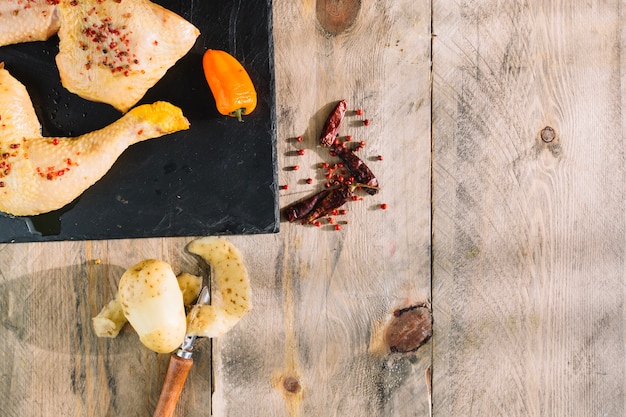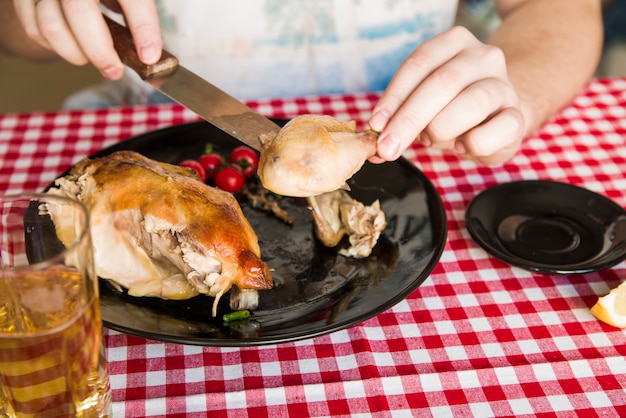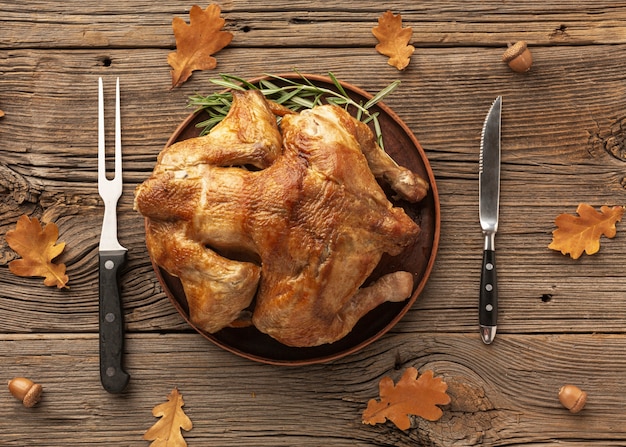Alright, chicken enthusiasts, gather round! You've got your beautiful bird, plump and ready for roasting, and you're brimming with excitement to tackle this classic dish. But hold on a minute, there's a little more to it than just tossing it in the oven, you know.
This guide is all about taking you on a journey through the art of cooking a perfect roast chicken. We'll delve into every detail, from selecting the ideal bird to achieving that golden-brown skin and juicy, tender meat that'll leave you craving for more.
(Part 1)
Choosing Your Bird: The Foundation of a Delicious Roast

First things first, let's talk about the star of the show – the chicken itself. You want to pick a bird that’s going to be bursting with flavour and cook up beautifully, leaving you with a dish that's a culinary triumph.
Free-Range vs. Organic: A Tale of Two Chickens
Personally, I’m a big fan of free-range chickens. They’ve got a better life, meaning they roam freely and have access to fresh air and sunshine. This translates to richer flavour in your finished dish. organic chickens are another great choice, as they're raised without the use of antibiotics and hormones, making them a healthier option for your table.
Size Matters: Finding the Right Fit
The size of your chicken will determine how long it needs to cook, so make sure you choose a bird that’s the right size for the number of people you’re feeding. A 1.5kg chicken is usually enough for two people, while a 2.5kg chicken will comfortably feed four to six hungry guests.
Checking for Freshness: Ensuring Quality
There are a few tell-tale signs to look for when picking out your chicken to ensure it’s fresh and ready to shine in your oven:
Smell: A fresh chicken should have a mild, clean smell. If it smells sour or ammonia-like, it’s a sign that it’s not fresh and should be avoided.
Colour: The skin of a fresh chicken should be a pale, creamy white. It shouldn’t be discoloured or have any green or yellow patches, which could indicate spoilage.
Feel: A fresh chicken should feel firm and springy to the touch. It shouldn’t be slimy or sticky, which are signs of bacteria growth.
Preparing Your Chicken: Setting the Stage for a Flavorful Feast

Once you’ve got your perfect bird, it’s time to prep it for roasting, getting it ready to shine in the oven.
1. Pat It Dry: Achieving crispy skin
First things first, pat the chicken dry with paper towels. This will help the skin to crisp up nicely in the oven, giving you that beautiful golden-brown colour we all crave.
2. Season Wisely: A Symphony of Flavours
Now it’s time to get creative with your seasonings. I always start with salt and pepper, but you can add whatever herbs and spices you like. Fresh rosemary, thyme, and sage are classic choices, but don’t be afraid to experiment! Think about your favourite flavours and how you can incorporate them into your chicken. A little paprika for a smoky kick, or a dash of dried oregano for a Mediterranean touch - the possibilities are endless.
3. Stuff It (or Don’t): A Matter of Personal Preference
You can stuff your chicken if you like, but it's not essential. Stuffing can add a lot of flavour and moisture, but it can also be a bit of a safety risk if it's not cooked thoroughly. If you do decide to stuff it, make sure you use a stuffing that's cooked separately, as it’s not recommended to cook stuffing inside the chicken.
4. Truss Up: Ensuring Even Cooking
Now, here's where things get a bit more technical. Trussing is the process of tying the chicken’s legs and wings together, which helps it to cook evenly and prevents the skin from drying out. This might sound complicated, but it’s a simple technique that makes a big difference in the final product.
Method 1: Kitchen String: The classic method involves using kitchen string to tie the legs and wings together, creating a neat and tidy package.
Method 2: Skewers: Alternatively, you can use metal skewers to hold the legs and wings in place, offering a slightly easier and faster method.
Cooking Your Chicken: The Grand Finale

Finally, we’re ready to cook!
1. Preheat Your Oven: The Crucial First Step
Preheat your oven to 200°C (400°F). This will ensure that the chicken cooks quickly and evenly, resulting in a juicy and flavorful meal.
2. Roast It Right: Timing is Everything
Place the chicken in a roasting pan and roast for 1 hour and 15 minutes, or until the internal temperature reaches 74°C (165°F). You can use a meat thermometer to check the temperature, ensuring it's cooked through without being overdone.
3. Basting for a Golden Glaze: Enhancing the Visual Appeal
Basting your chicken during cooking will give it that beautiful golden brown skin that’s not only visually appealing but also adds another layer of flavour. Simply spoon some of the drippings from the roasting pan over the chicken every 20 minutes or so, allowing the flavours to penetrate the meat and create a beautiful glaze.
Resting is Key: The Art of Patience
After roasting, let the chicken rest for 10 minutes before carving. This allows the juices to redistribute throughout the meat, resulting in a more tender and flavorful dish. This is a crucial step that often gets overlooked, but it really makes a difference in the final outcome.
(Part 2)
Serving Your roast chicken: A Feast for the Senses
Now comes the fun part – serving up your delicious roasted chicken!
1. Carving: Unveiling the Culinary Masterpiece
Carve your chicken carefully, using a sharp knife to separate the legs, breasts, and wings. Be gentle as you slice through the meat, ensuring the juices stay locked inside, creating a moist and flavorful experience for your guests.
2. Accompaniments: A Symphony of Flavors
Roast chicken goes perfectly with a variety of side dishes, each adding its own unique touch to the meal. Here are a few of my favourites:
Roasted Potatoes: A classic combination, simply roast some potatoes with garlic, rosemary, and olive oil. The potatoes absorb the flavours of the herbs and oil, creating a delicious and satisfying side dish.
green beans: Steam or roast some green beans for a healthy and delicious side dish that adds a touch of freshness to the meal. You can even add some toasted almonds or a squeeze of lemon for a touch of extra flavour.
Gravy: A rich and flavorful gravy will make your roast chicken even more satisfying. It adds a silky smooth texture and intensifies the overall flavour experience.
Salad: A fresh salad will balance out the richness of the chicken, adding a burst of colour and freshness to the meal.
The Ultimate Roast chicken recipe: A Step-by-Step Guide
Now, let's get down to business and give you the recipe for the perfect roast chicken. This is a recipe that's been tried and tested countless times, ensuring you get a delicious and satisfying result.
Ingredients:
1 whole chicken (1.5-2.5kg)
2 tablespoons olive oil
1 tablespoon salt
1 teaspoon black pepper
1 teaspoon dried rosemary
1 teaspoon dried thyme
1/2 teaspoon dried sage
Instructions:
1. Preheat your oven to 200°C (400°F).
2. Pat the chicken dry with paper towels. This ensures the skin crisps up nicely.
3. In a small bowl, combine the olive oil, salt, pepper, rosemary, thyme, and sage. This creates a beautiful flavour blend that will permeate the chicken.
4. Rub the seasoning mixture all over the chicken, making sure to get under the skin. This allows the flavours to penetrate the meat thoroughly.
5. Truss the chicken. This ensures even cooking and prevents the skin from drying out.
6. Place the chicken in a roasting pan.
7. Roast for 1 hour and 15 minutes, or until the internal temperature reaches 74°C (165°F). Use a meat thermometer to ensure it's cooked through.
8. Baste the chicken every 20 minutes with the drippings from the roasting pan. This adds moisture and enhances the golden-brown skin.
9. Let the chicken rest for 10 minutes before carving. This allows the juices to redistribute, resulting in a more tender and flavorful dish.
Troubleshooting Your Roast Chicken: Addressing Common Challenges
Sometimes things don’t go exactly as planned, and you might encounter a few hiccups along the way. Here are some common problems you might encounter and how to fix them:
1. Dry Chicken: Remedying a Common Issue
If your chicken is dry, you might have cooked it for too long or not basted it enough. This can happen even to the most experienced cooks.
Solution: Try covering the chicken with foil for the last 30 minutes of cooking time. This creates a moist environment that helps retain the juices.
2. undercooked chicken: Ensuring Safety and Flavor
If your chicken is undercooked, you’ll need to cook it for longer to ensure it's safe to eat and achieve the desired texture and flavour.
Solution: Cook the chicken for an additional 15-20 minutes, or until the internal temperature reaches 74°C (165°F). Always use a meat thermometer to check the temperature accurately.
3. Burnt Skin: Achieving the Perfect Golden Brown
If the skin of your chicken is burnt, you might have cooked it at too high a temperature. This can result in a burnt exterior and an undercooked interior.
Solution: Reduce the oven temperature by 25°C (50°F) for the remaining cooking time. This will help the chicken cook more evenly without burning the skin.
Leftover Chicken Ideas: Putting Those Delicious Scraps to Good Use
Got leftover roast chicken? No problem! There are so many delicious ways to use it up, transforming it into new and exciting dishes. Here are a few ideas:
chicken salad: Combine shredded chicken with mayonnaise, celery, onion, and your favourite herbs. This is a classic and refreshing way to use up leftover chicken.
Chicken Soup: Use the leftover chicken to make a hearty and flavorful soup. Add vegetables, noodles, and your favorite seasonings for a comforting and nourishing meal.
Chicken Quesadillas: Fill tortillas with shredded chicken, cheese, and your favourite toppings. This is a quick and easy way to enjoy leftover chicken.
Chicken Stir-Fry: Add leftover chicken to your favourite stir-fry recipe. This is a versatile way to use leftover chicken and create a quick and flavourful meal.
(Part 3)
FAQs: Addressing Your Burning Questions
1. Can I freeze a whole chicken?
Yes, you can freeze a whole chicken. Wrap it tightly in plastic wrap or aluminum foil and freeze for up to 3 months. Freezing is a great way to extend the shelf life of your chicken.
2. What's the best way to thaw a frozen chicken?
The safest way to thaw a frozen chicken is in the refrigerator. It will take about 24 hours to thaw completely. You can also thaw a chicken in cold water, but make sure the water is constantly changing. This ensures the chicken thaws evenly and safely.
3. What happens if I overcook a chicken?
Overcooked chicken will be dry and tough. If you accidentally overcook your chicken, there’s not much you can do to fix it, but you can try adding some sauce or gravy to help make it more moist. It's best to avoid overcooking by using a meat thermometer and keeping a close eye on the cooking time.
4. How can I tell if my chicken is cooked properly?
The best way to tell if your chicken is cooked properly is to use a meat thermometer. Insert the thermometer into the thickest part of the thigh (not touching the bone) and make sure the temperature reaches 74°C (165°F).
5. Can I cook a chicken from frozen?
While it is technically possible to cook a chicken from frozen, it’s not recommended. It will take longer to cook and the chicken may not cook evenly. It’s best to thaw the chicken completely before cooking it. This ensures a safe and delicious outcome.
(Part 4)
Beyond the Basics: Taking Your Roast Chicken to the Next Level
Now that you've got the basics down, let’s talk about taking your roast chicken game to the next level, creating a dish that truly stands out.
1. Experiment with Flavours: Unleashing Your Culinary Creativity
Don’t be afraid to get creative with your seasonings! Try using different herbs and spices, or even adding a little bit of citrus zest. The possibilities are endless.
2. Give It a Brine: Enhancing Flavor and Moisture
Brining is the process of soaking meat in a salt solution. This helps to make the chicken more flavorful and juicy, resulting in a tender and succulent final product.
3. Roast It with Vegetables: A Complete Meal in One Dish
Roasting your chicken with vegetables is a great way to add flavour and make a complete meal. Try roasting your chicken with potatoes, carrots, onions, or garlic. This is a convenient and delicious way to enjoy a one-pot meal.
4. Don’t Forget the Pan Sauce: A Flavorful Finish
The drippings from the roasting pan can be used to make a delicious pan sauce. Deglaze the pan with wine or stock, then thicken the sauce with flour or cornstarch. This adds an extra layer of flavour and richness to the dish.
(Part 5)
The Art of Roasting: Insights from a Chicken Enthusiast
I've been roasting chickens for years, and I’ve picked up a few tricks along the way, which I'd love to share with you.
1. Patience is Key: Embracing the Process
Cooking a whole chicken takes time, so don't rush the process. Be patient and let the chicken cook slowly and evenly. This allows the flavours to develop and the meat to become tender and juicy.
2. Invest in a Good Thermometer: Ensuring Accuracy
A meat thermometer is essential for ensuring your chicken is cooked properly. It’s also a great tool for checking the temperature of other meats, like beef, pork, and lamb.
3. Don't Overcrowd the Oven: Ensuring Even Cooking
If you’re roasting multiple chickens, make sure they have enough space in the oven to cook evenly. This prevents overcrowding and ensures each chicken cooks thoroughly.
(Part 6)
Beyond Roast Chicken: Exploring Other Chicken cooking techniques
While roasting is a classic way to cook chicken, it's not the only way. There's a whole world of chicken cooking techniques to explore, each offering its own unique flavour and texture.
1. Fried Chicken: A Crispy and Delicious Classic
Fried chicken is a popular and delicious option. It’s important to use the right temperature and oil for the best results, achieving that perfect crispy exterior and juicy interior.
2. grilled chicken: A Summertime Favorite
Grilled chicken is a great option for summer cookouts. Marinate the chicken before grilling to add flavour, enhancing the taste and creating a delightful meal.
3. Slow-Cooked Chicken: A Tender and Flavorful Choice
slow cooking is a great way to create tender and flavorful chicken. It’s perfect for busy weeknights, allowing you to cook a delicious meal with minimal effort.
4. Poached Chicken: A Delicate and Flavorful Option
Poached chicken is a delicate and flavorful option. It’s often served with a light sauce or salad, adding a touch of elegance to any meal.
(Part 7)
Tips for chicken safety: Handling Chicken With Care
Chicken is a popular food, but it's important to handle it safely to prevent food poisoning. Here are some key safety tips to keep in mind:
1. Keep It Cold: Preventing Bacterial Growth
Store your chicken in the refrigerator at 4°C (40°F) or below. This helps prevent bacterial growth and ensures the safety of your chicken.
2. Don’t Cross-Contaminate: Protecting Your Food
Make sure to wash your hands and surfaces thoroughly after handling raw chicken. Use separate cutting boards for raw meat and produce. This prevents the spread of bacteria to other foods.
3. Cook It Thoroughly: Ensuring food safety
Cook your chicken to an internal temperature of 74°C (165°F). Use a meat thermometer to ensure the chicken is cooked thoroughly and safe to eat.
4. Don’t Let It Sit Out: Preventing Bacterial Growth
Don't let cooked chicken sit out at room temperature for more than two hours. This can lead to bacterial growth, making the chicken unsafe to eat.
(Part 8)
Final Thoughts: The Joy of a Perfectly Cooked Roast Chicken
There’s nothing quite like the satisfaction of cooking a perfect roast chicken. It’s a meal that brings people together and fills the home with delicious aromas.
So go ahead, get your hands on a beautiful bird, and try out these tips and tricks. You’ll be amazed at how easy it is to cook a roast chicken that will impress your family and friends. Happy cooking!
Everyone is watching

Prime Rib Roast Cooking Time Chart: Per Pound Guide
Cooking TipsPrime rib roast. Just the name conjures images of lavish dinners, crackling fires, and hearty laughter. It’s ...

How Long to Bake Potatoes in the Oven (Perfect Every Time)
Cooking TipsBaked potatoes are a staple in my kitchen. They're incredibly versatile, delicious, and surprisingly easy to m...

Perfect Rice Every Time: The Ultimate Guide to Cooking Rice
Cooking TipsAs a self-proclaimed foodie, I've always been a bit obsessed with rice. It's the foundation of countless cuisi...

The Ultimate Guide to Cooking Asparagus: Tips, Techniques, and Recipes
Cooking TipsAsparagus. The mere mention of this spring delicacy conjures up images of vibrant green spears, crisp and burs...

Ultimate Guide to Cooking the Perfect Thanksgiving Turkey
Cooking TipsThanksgiving. Just the word conjures up images of overflowing tables laden with delicious food, the scent of r...
